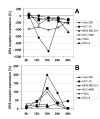Irradiation specifically sensitises solid tumour cell lines to TRAIL mediated apoptosis
- PMID: 15651986
- PMCID: PMC547906
- DOI: 10.1186/1471-2407-5-5
Irradiation specifically sensitises solid tumour cell lines to TRAIL mediated apoptosis
Abstract
Background: TRAIL (tumor necrosis factor related apoptosis inducing ligand) is an apoptosis inducing ligand with high specificity for malignant cell systems. Combined treatment modalities using TRAIL and cytotoxic drugs revealed highly additive effects in different tumour cell lines. Little is known about the efficacy and underlying mechanistic effects of a combined therapy using TRAIL and ionising radiation in solid tumour cell systems. Additionally, little is known about the effect of TRAIL combined with radiation on normal tissues.
Methods: Tumour cell systems derived from breast- (MDA MB231), lung--(NCI H460) colorectal--(Colo 205, HCT-15) and head and neck cancer (FaDu, SCC-4) were treated with a combination of TRAIL and irradiation using two different time schedules. Normal tissue cultures from breast, prostate, renal and bronchial epithelia, small muscle cells, endothelial cells, hepatocytes and fibroblasts were tested accordingly. Apoptosis was determined by fluorescence microscopy and western blot determination of PARP processing. Upregulation of death receptors was quantified by flow cytometry.
Results: The combined treatment of TRAIL with irradiation strongly increased apoptosis induction in all treated tumour cell lines compared to treatment with TRAIL or irradiation alone. The synergistic effect was most prominent after sequential application of TRAIL after irradiation. Upregulation of TRAIL receptor DR5 after irradiation was observed in four of six tumour cell lines but did not correlate to tumour cell sensitisation to TRAIL. TRAIL did not show toxicity in normal tissue cell systems. In addition, pre-irradiation did not sensitise all nine tested human normal tissue cell cultures to TRAIL.
Conclusions: Based on the in vitro data, TRAIL represents a very promising candidate for combination with radiotherapy. Sequential application of ionising radiation followed by TRAIL is associated with an synergistic induction of cell death in a large panel of solid tumour cell lines. However, TRAIL receptor upregulation may not be the sole mechanism by which sensitation to TRAIL after irradiation is induced.
Figures





Similar articles
-
The sequential treatment with ionizing radiation followed by TRAIL/Apo-2L reduces tumor growth and induces apoptosis of breast tumor xenografts in nude mice.Int J Oncol. 2004 May;24(5):1133-40. Int J Oncol. 2004. PMID: 15067334
-
Ionizing radiation enhances the therapeutic potential of TRAIL in prostate cancer in vitro and in vivo: Intracellular mechanisms.Prostate. 2004 Sep 15;61(1):35-49. doi: 10.1002/pros.20069. Prostate. 2004. PMID: 15287092
-
Synergistic induction of apoptosis in neuroblastoma cells using a combination of cytostatic drugs with interferon-gamma and TRAIL.Int J Oncol. 2004 Dec;25(6):1849-57. Int J Oncol. 2004. PMID: 15547726
-
[Death inducing ligands in combination with ionizing radiation: objective and current knowledge].Strahlenther Onkol. 2003 Mar;179(3):141-51. doi: 10.1007/s00066-003-1047-7. Strahlenther Onkol. 2003. PMID: 12627256 Review. German.
-
TRAIL and chemotherapeutic drugs in cancer therapy.Vitam Horm. 2004;67:365-83. doi: 10.1016/S0083-6729(04)67019-1. Vitam Horm. 2004. PMID: 15110186 Review.
Cited by
-
Bax/Bak-independent mitochondrial depolarization and reactive oxygen species induction by sorafenib overcome resistance to apoptosis in renal cell carcinoma.J Biol Chem. 2017 Apr 21;292(16):6478-6492. doi: 10.1074/jbc.M116.754184. Epub 2017 Feb 1. J Biol Chem. 2017. PMID: 28154184 Free PMC article.
-
Immunomodulation of NK Cells by Ionizing Radiation.Front Oncol. 2020 Jun 16;10:874. doi: 10.3389/fonc.2020.00874. eCollection 2020. Front Oncol. 2020. PMID: 32612950 Free PMC article. Review.
-
TRAIL receptor signaling and therapeutic option in bone tumors: the trap of the bone microenvironment.Am J Cancer Res. 2012;2(1):45-64. Epub 2011 Oct 9. Am J Cancer Res. 2012. PMID: 22206045 Free PMC article.
-
Irradiation leads to sensitization of hepatocytes to TNF-alpha-mediated apoptosis by upregulation of IkappaB expression.Radiat Environ Biophys. 2009 Feb;48(1):85-94. doi: 10.1007/s00411-008-0200-1. Epub 2008 Oct 28. Radiat Environ Biophys. 2009. PMID: 18956207
-
Proapoptotic activity of Ukrain is based on Chelidonium majus L. alkaloids and mediated via a mitochondrial death pathway.BMC Cancer. 2006 Jan 17;6:14. doi: 10.1186/1471-2407-6-14. BMC Cancer. 2006. PMID: 16417634 Free PMC article.
References
Publication types
MeSH terms
Substances
LinkOut - more resources
Full Text Sources
Research Materials
Miscellaneous

